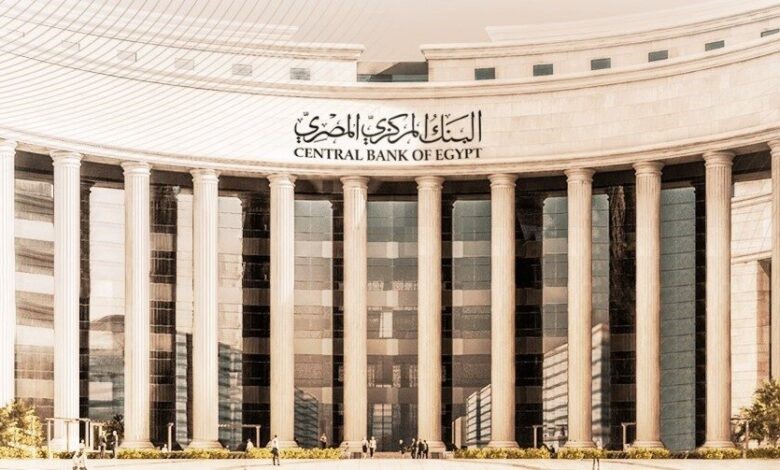The Monetary Policy Committee (MPC) of the Central Bank of Egypt (CBE) will hold its seventh regular meeting of the year tomorrow, Thursday, to determine the direction of the key policy interest rates, which remain the primary indicator guiding short-term pound interest rates. The meeting comes at a time when expert opinions and investment-bank projections are sharply divided between maintaining current rates and implementing a limited rate cut.
Earlier in October, the MPC reduced the Central Bank’s key policy rates by 1%, bringing the overnight deposit rate to 21%, the overnight lending rate to 22%, and both the credit and discount rate and the main operation rate to 21.5%. The Committee described that move as appropriate for preserving a monetary policy stance that anchors expectations while supporting the anticipated downward path of inflation. It nevertheless noted that inflation expectations continue to face upside risks, both domestically and internationally, including administratively set price increases that exceeded earlier estimates and the intensifying geopolitical tensions in the region.
The CBE recently announced that the annual core inflation rate increased to 12.1% in October 2025, compared with 11.3% in September. It also reported that the monthly rate of change in the core consumer price index it compiles reached 2% in October 2025, compared with 1.3% in October 2024 and 1.5% in September 2025.
CAPMAS figures showed that annual inflation in Egyptian cities rose to 12.5% in October, compared with 11.7% in September. This increase had been broadly anticipated, following the government’s October decision to raise petroleum-product prices by between 10.5% and 12.9%. At the same time, CAPMAS revealed a marginal decline in the nationwide inflation rate, which eased to 10.1% in October from 10.3% in September. According to its monthly inflation bulletin, the national consumer price index reached 264.3 points in October, marking a 1.3% rise compared with September.
Arguments for a Rate Cut
Banking expert Mohamed Abdel Aal believes the MPC is likely to prioritise stimulating economic growth and reducing public-debt burdens by introducing a limited interest-rate cut at Thursday’s meeting. He argues that the strategic considerations favouring a cut outweigh the short-term forces that might otherwise support maintaining current rates.
Abdel Aal stressed that MPC decisions are not based primarily on past inflation readings but on expectations regarding the inflation outlook. For this reason, he said, the rise in inflation in October should not prevent a rate cut, provided the Committee remains confident in its overall assessment of Egypt’s domestic and international economic balance.
He further noted that the MPC carefully evaluates counter-inflationary forces to determine whether they are strong enough to absorb shocks arising from administrative price adjustments. For example, Committee experts assess whether the fuel-price increase will lead to a one-time impact or whether it may evolve into broader, persistent inflation known as the second-round effect.

According to Abdel Aal, the most significant factor pushing the CBE toward a rate cut is its commitment to achieving the future inflation target. The Bank aims to bring average inflation down to 7% ±2% by the end of 2026, a goal that requires the nominal interest rate to decline substantially to about 13%-15%. With current average interest rates around 21.25%, the MPC would need to reduce rates by between 600 and 800 basis points over the medium term, which supports the case for accelerating cuts between now and the end of next year.
He added that expectations of global interest-rate reductions for the US dollar constitute an important external factor. Major central banks, including the US Federal Reserve, have been cutting rates, which means the interest-rate differential between the Egyptian pound and the dollar will remain attractive to foreign portfolio investors even if Egypt implements cuts. This dynamic gives the CBE flexibility to reduce rates in support of economic activity without risking a decline in foreign capital flows.
Abdel Aal also pointed out that Egypt’s real interest rate remains high at roughly 8.75%, which he described as contractionary and detrimental to growth. Lower interest rates, he said, are essential for easing borrowing costs for companies and individuals, stimulating investment and consumption, and boosting economic expansion. He further emphasised that rate cuts directly reduce government debt-servicing costs, saving around EGP 70bn for every one-percentage-point cut—a crucial fiscal factor.
He highlighted that the improvement or strong stability in the value of the Egyptian pound against the US dollar reduces the cost of importing production inputs and final goods, creating a counter-inflationary effect known as “imported-inflation relief.” This helps producers avoid passing all domestic cost increases—such as higher transport expenses due to fuel-price hikes—on to consumers.
Abdel Aal added that repeated rate cuts do not have immediate effects; rather, they work gradually by reducing companies’ financing costs. As financing becomes more affordable, companies can either lower prices to become more competitive or absorb part of their rising energy and input costs instead of transferring them entirely to consumers. This, in turn, supports economic growth.
Arguments for Holding Rates
However, he noted that there are also understandable arguments for keeping rates unchanged. The increase in core inflation to 12.1% suggests that the fuel shock may not have been limited to a one-off direct effect, but may already be spilling into prices of other goods and services, raising the risk of second-round inflation. This necessitates caution. Abdel Aal said the CBE may need to analyse the inflation shock resulting from the October increase and may prefer to wait another month to review the November inflation reading before determining whether October’s spike was temporary or the beginning of a new upward trend.
Commenting on expected scenarios, Abdel Aal said: “I expect the Committee may prioritise stimulating growth and reducing debt by implementing a limited interest-rate cut ranging between 50 and 100 basis points at the upcoming meeting, followed by an additional cut between 100 and 150 basis points in December if inflation begins to decline, in order to avoid generating new inflationary expectations after October’s inflation increase.” He added, “Accordingly, the expectation of a total cut of 200 basis points before the end of the year, distributed across the 20 November and 25 December meetings, remains possible. This limited cut expected in Thursday’s meeting ensures the continuation of the trajectory towards the 2026 target while sending a message to the market that the Committee is monitoring November’s inflation data before taking larger decisions in December.”
Banking expert Shaimaa Wageeh said that tomorrow’s MPC meeting is widely regarded as a true test of the CBE’s ability to manage monetary stability under sensitive economic circumstances, especially after the Bank cut interest rates by 100 basis points in October to 21% for deposits and 22% for lending. Wageeh noted that current economic indicators show that annual inflation remains elevated due to rising fuel prices and higher costs for basic goods, which necessitate caution. At the same time, she said exchange-rate stability and flexibility in foreign reserves give the CBE room to take a measured step, whether by holding rates steady or implementing a limited cut.

According to Wageeh, a decision to hold rates appears the more likely scenario, as it reflects the Central Bank’s desire to preserve price stability and avoid triggering an inflationary wave that could arise from rapid monetary easing. She said this option also reinforces confidence among foreign and domestic investors in the CBE’s ability to manage market expectations prudently.
She added that a limited cut remains possible, particularly if pre-meeting data indicate a slowdown in monthly inflation or stability in the core inflation basket, which would allow for moderate stimulation of credit and investment without compromising monetary stability. Wageeh said such a move would demonstrate a flexible and strategic approach that balances support for economic growth with the need to contain inflation risks. The key message, she said, is not merely the interest-rate adjustment itself but the broader strategic direction of monetary policy, which prioritises stability while gradually creating conditions conducive to future growth.
Wageeh noted that the meeting may also illustrate Egypt’s growing economic maturity and the ability of policymakers to balance short-term pressures with medium- and long-term considerations. “In short, the Egyptian economy is at a critical stage requiring a mix of caution and strategic judgement, and holding rates remains the more probable scenario at this moment, with the option of a limited cut remaining open if inflation indicators and the core price basket improve by the end of the month,” she said. Wageeh added that the upcoming decision is not simply a numerical adjustment but a strategic signal to markets that aims to support economic confidence in the coming period.
Conditions Allow for Possible Cut
HC Securities said that while the CBE may choose to keep rates unchanged at its upcoming meeting, current economic conditions leave space for a possible 100-basis-point cut to support economic activity and stimulate the private sector. The company said Egypt’s external financial position has demonstrated noticeable resilience in recent months. It cited an increase in net international reserves of 1% month-on-month and a 6% rise since the beginning of the year, reaching a record $50.1bn in October. HC also reported an improvement in the banking sector’s net foreign assets, which grew nearly 16% month-on-month to $20.8bn in September, up almost fourfold since the start of the year.

The firm highlighted a 35% year-on-year jump in remittances in August to $3.5bn, although there was a slight month-on-month decline. HC further noted that Egypt’s one-year credit default swap rate fell sharply to 176 basis points from 379 at the beginning of the year, indicating an improved credit outlook for the country, alongside a rebound in Suez Canal revenues since early November following the Gaza ceasefire agreement. These developments collectively contributed to an 8% appreciation of the Egyptian pound against the US dollar since the start of the year.
Domestically, HC pointed to several noteworthy developments, including the rise in the non-oil private-sector PMI to 49.2 in October from 48.8 in September, driven by improved demand, though it remains below the 50-point threshold that signals expansion.
Regarding inflation, HC noted an 11% accumulated increase in prices during the first ten months of 2025, compared with 22% in the same period of 2024. Inflation recorded 1.8% month-on-month and 12.5% year-on-year in October. The firm expects inflation to rise to 13% in November due to the mid-October energy-price increases before declining again due to the base effect.
On the attractiveness of government debt instruments, HC reported that the latest 12-month treasury-bill issuance carried a yield of 25.49%, representing a positive real return of about 10.7% based on expected inflation of 11%, after applying the 15% tax imposed on foreign investors. The company added that the marked decline in Egypt’s credit-risk indicators suggests that foreign-investor yield requirements may continue to fall, though this has not yet been fully reflected in the market.
HC concluded that although a rate hold is entirely plausible, a rate cut remains strongly on the table due to the improvement in external-sector indicators, the relative easing of inflationary pressures, and the need to support economic activity and the private sector.
Reuters Poll and Investment-Bank Expectations
A Reuters poll showed that the CBE may lower overnight interest rates by an average of 50 basis points at Thursday’s meeting. Fourteen analysts expected the MPC to cut the deposit rate to 20.5% from 21% and the lending rate to 21.5% from 22%. A note issued by Abu Dhabi Commercial Bank stated that real interest rates in Egypt remain significantly positive despite the acceleration of consumer-price growth in October, leaving room for a rate cut. However, Mohamed Abu Basha of EFG Hermes said, “The elevated inflation reading in October and the need to assess the impact of the latest fuel-price increases lead us to expect the MPC to keep interest rates unchanged at its next meeting.”
Meanwhile, 11 investment banks—including EFG Hermes, CI Capital, Naeem, Zilla Capital, Ahli Faros, Prime, Mubasher Financial Services, Thndr, Cairo Capital, Arabia Online and Sigma—expect the Central Bank to keep interest rates unchanged at tomorrow’s meeting due to the rise in fuel prices and their inflationary effect.
Despite inflation climbing to 12.5% in October, some experts believe that interest rates may be cut later as economic conditions improve. Others expect a small cut to support the non-oil private sector.
The CBE has already cut interest rates by a total of 6.25% so far this year, with reductions of 2.25% in April, 1% in May, 2% in August and 1% in October. Despite these cuts, Egypt’s real interest rates remain among the highest globally.




